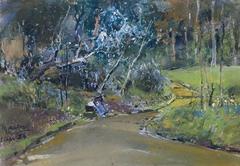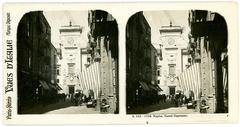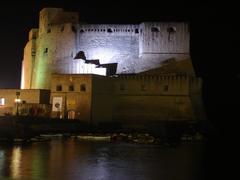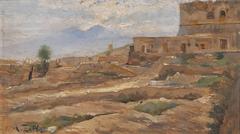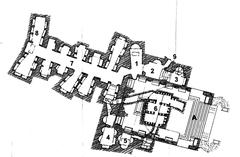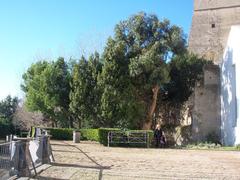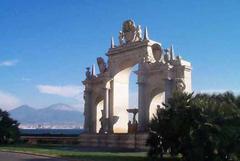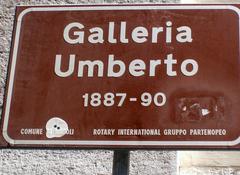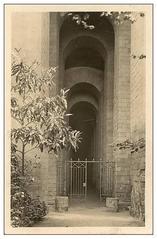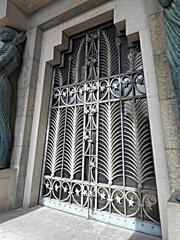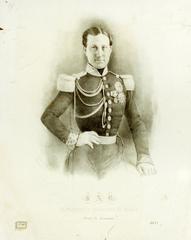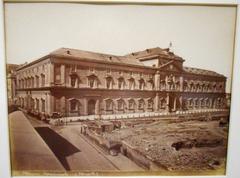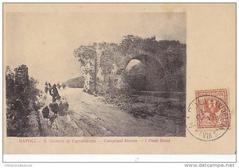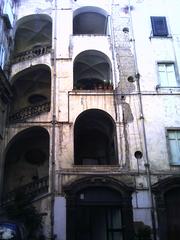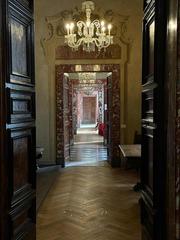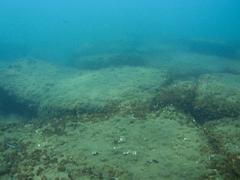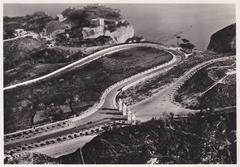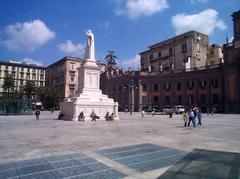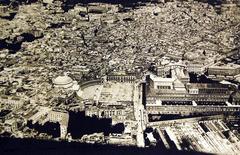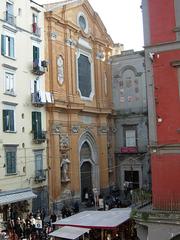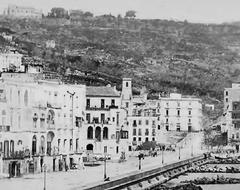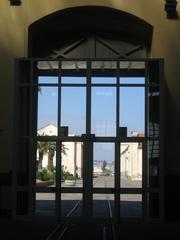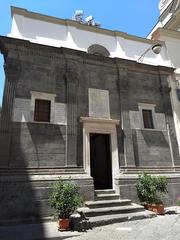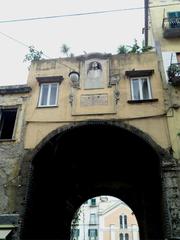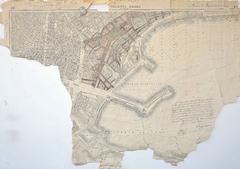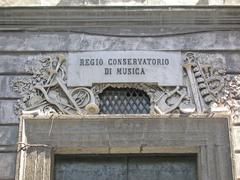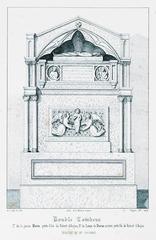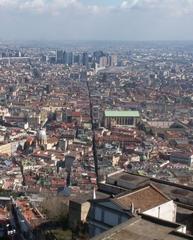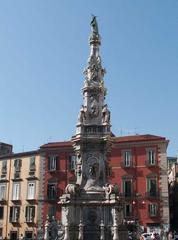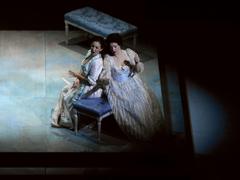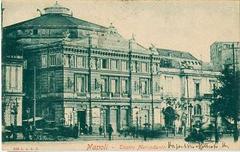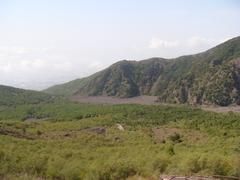
Dante Piazza Naples Visiting Hours, Tickets, and Historical Sites Guide
Date: 04/07/2025
Introduction to Piazza Dante Naples: History and Significance
Piazza Dante in Naples, Italy, stands as a vivid testament to the city’s layered history, artistic legacy, and dynamic contemporary life. Situated at the threshold of Naples’ historic center, this iconic square is instantly recognizable for its grand hemicycle—an 18th-century architectural marvel designed by Luigi Vanvitelli. Originally intended as a monumental gateway under Charles III of Bourbon, Piazza Dante exemplifies Enlightenment principles with its harmonious semicircular colonnade and twenty-six statues symbolizing royal virtues. The central statue of Dante Alighieri, Italy’s literary giant, pays homage to national culture and underscores the city’s enduring identity.
Beyond its architectural splendor, Piazza Dante serves as a lively urban hub, surrounded by historic churches, educational institutions, and the celebrated Dante Metro Station—part of Naples’ renowned “Metro dell’Arte.” Open to the public at all hours, the square is a focal point for daily life and cultural events. This detailed guide covers everything you need to know: from practical visiting information to the square’s cultural significance and top nearby attractions. Explore the heart of Naples, where centuries-old heritage and modern vibrancy coexist seamlessly (Napolike; Booking Naples; Lonely Planet; Trip.com).
Table of Contents
- Introduction
- Historical Evolution of Piazza Dante
- Practical Visitor Information
- Cultural Significance of Piazza Dante
- The Hemicycle Design and Urban Layout
- The Statue of Dante Alighieri
- Architectural Landmarks Surrounding the Square
- The Dante Metro Station: A Contemporary Artistic Landmark
- Artistic Paving and Urban Furnishings
- Integration of Old and New
- Vibrant Public Life and Social Atmosphere
- Cultural Events and Artistic Programming
- Gastronomy, Cafés, and Nightlife
- Accessibility and Urban Connectivity
- Safety, Inclusivity, and Local Customs
- Practical Visitor Information and Local Insights
- Getting to Piazza Dante and Navigating the Area
- Facilities and Amenities
- Safety and Local Etiquette
- Best Times to Visit and Weather Considerations
- Accessibility
- Local Insights: Experiencing Piazza Dante Like a Neapolitan
- Dining and Refreshments
- Shopping and Markets
- Events and Cultural Activities
- Practical Tips for Visitors
- Nearby Attractions
- Tourist Information and Support
- Visuals and Interactive Media Recommendations
- Frequently Asked Questions (FAQ)
- Conclusion and Call to Action
Historical Evolution of Piazza Dante
Origins and Urban Development
Located at the intersection of Via Toledo and Port’Alba, Piazza Dante’s history is rooted in the mid-18th century. Under Charles III of Bourbon, architect Luigi Vanvitelli redesigned the area between 1757 and 1765, transforming the former market space, Largo del Mercatello, into a ceremonial gateway to Naples’ historic core (Napolike). The hemicycle’s semi-circular plan and monumental scope reflect Enlightenment ideals—order, reason, and civic virtue.
Architectural Features and Symbolism
The square’s signature hemicycle is adorned with twenty-six statues, each embodying a royal virtue, reinforcing the legitimacy and progressive values of Bourbon rule (Napolike). The arcaded Neoclassical façade, rhythmic arches, and Doric columns exemplify Vanvitelli’s architectural vision.
At the center, the marble statue of Dante Alighieri, crafted in 1871 by Tito Angelini and Tommaso Solari Junior, celebrates the 600th anniversary of Dante’s birth—a powerful symbol of national pride (Booking Naples).
Religious and Educational Landmarks
The square is bordered by significant buildings: the National Convitto Vittorio Emanuele II (former Convent of San Sebastiano) and Baroque churches such as Santa Maria di Caravaggio, San Domenico Soriano, San Michele a Port’Alba, and the Church of the Immaculate Health Workers. These structures illustrate the square’s longstanding role in Naples’ religious, educational, and community life (Napolike).
Modern Adaptations and Urban Life
Since 2002, Piazza Dante has become a major public transport interchange, integrating Metro Line 1 while preserving the area’s historic integrity (Napolike). Today, it remains a lively gathering place, open and accessible to all (Trip.com).
Practical Visitor Information
- Visiting Hours: Piazza Dante is open and accessible 24/7.
- Tickets: No fee to enter the square; ticketed entry may apply for nearby museums and churches.
- Guided Tours: Available from local operators; advance booking is advised.
- Accessibility: The square and Metro are wheelchair-accessible, with ramps and elevators.
- Best Time to Visit: Early morning or late afternoon for ideal lighting and smaller crowds.
- Nearby Attractions: Via Toledo, Port’Alba, Naples National Archaeological Museum, Decumano Maggiore.
- Photo Spots: The hemicycle, Dante statue at sunrise, panoramic views from elevated points nearby.
Cultural Significance of Piazza Dante
Enlightenment Ideals and Civic Identity
The square’s plan and iconography reflect the Enlightenment belief in reason, virtue, and public life. The statues of royal virtues and the dedication to Dante Alighieri underscore civic pride and Italian unity (Napolike).
Social and Cultural Exchange
Historically, Piazza Dante has hosted markets, festivals, rallies, and performances, making it a crossroads for Neapolitan social, academic, and artistic communities (Travalour).
Religious and Artistic Heritage
Surrounding churches are rich in Baroque art and serve as important religious centers (Napolike). The Dante statue is a focal point for national memory and urban life.
Contemporary Relevance
The square continues to host public events and festivals, maintaining its role as a cultural hub (Trip.com).
The Hemicycle Design and Urban Layout
Piazza Dante’s sweeping hemicycle, designed by Vanvitelli, is defined by 26 statues representing royal virtues, robust Doric columns, and a sense of grandeur emblematic of Enlightenment urban planning (Booking Naples). This design frames the square, creating a majestic civic space for both ceremonial events and daily life.
The Statue of Dante Alighieri
At the square’s heart stands the marble statue of Dante, sculpted in 1871. The poet is depicted holding the Divine Comedy, symbolizing Naples’ intellectual heritage and the square’s identity (Booking Naples).
Architectural Landmarks Surrounding Piazza Dante
Notable buildings include:
- Vittorio Emanuele II High School: Once the Convent of San Sebastiano, this stately structure emphasizes the area’s educational importance.
- Baroque Churches: The Church of the Immaculate Conception of Healthcare Workers, Santa Maria di Caravaggio, San Michele in Port’Alba, and San Domenico Soriano, each with unique artistic features (Booking Naples).
The Dante Metro Station: A Contemporary Artistic Landmark
Architectural Integration
Opened in 2002 and designed by Gae Aulenti, the Dante Metro Station features entrances that blend seamlessly with the hemicycle and upgraded Etna stone paving, respecting the area’s historical features (Domusweb).
Artistic Highlights
The station houses works by renowned artists:
- Carlo Alfano
- Joseph Kosuth: Illuminated Dante quotations.
- Jannis Kounellis: Industrial installations.
- Michelangelo Pistoletto: Mediterranean-themed mirrors.
- Nicola De Maria: Colorful mosaic installations.
Archaeological and Historical Displays
The station’s upper entrance features classical sculpture reproductions and archaeological finds, connecting commuters to Naples’ ancient past (Visit Naples).
Artistic Paving and Urban Furnishings
The square’s dark volcanic stone paving, in keeping with 18th-century designs, and discreet modern furnishings preserve the monumental character (Domusweb).
Integration of Old and New
Piazza Dante exemplifies Naples’ ability to harmonize its historic roots with contemporary art and urban life (Booking Naples; Domusweb).
Vibrant Public Life and Social Atmosphere
The square is a lively gathering space: families, students, and travelers meet for conversation, street performances, and evening strolls. The open, pedestrian-friendly layout fosters spontaneous events and daily rituals (Nomads Travel Guide; Lonely Planet).
Cultural Events and Artistic Programming
Piazza Dante hosts concerts, open-air art exhibitions, festivals, and inclusive celebrations such as the Mediterranean Pride of Naples (The Best Naples; Gay Travel 4U). Temporary markets and fairs offer authentic local experiences.
Gastronomy, Cafés, and Nightlife
A diverse mix of cafés, pizzerias, and bars line the square and surrounding streets. Outdoor seating, live music, and proximity to bookshops and literary venues on Via Toledo and Port’Alba create a vibrant evening scene (The Best Naples).
Accessibility and Urban Connectivity
Strategically located, Piazza Dante features excellent transport links via Metro (Line 1) and city buses. The square is largely flat and accessible, though adjacent historic streets may be uneven (The Best Naples).
Safety, Inclusivity, and Local Customs
Piazza Dante is safe during daytime and early evening. Remain vigilant against petty theft and respect local customs—greet shopkeepers and enjoy the café culture. The square is a venue for inclusive events, reflecting Naples’ welcoming spirit (Curious Sparrow Travel; Gay Travel 4U).
Practical Visitor Information and Local Insights
Getting to Piazza Dante and Navigating the Area
Reachable via Metro Line 1 (Dante station), city buses, and taxis, Piazza Dante is centrally located and easily accessible from Naples Central Station and other major neighborhoods (Renato Prosciutto; Visit Naples).
Facilities and Amenities
The square offers benches, shaded areas, and is surrounded by shops and restaurants. Public toilets are found in nearby cafés for customers; free Wi-Fi is available in some spots. The main Naples Visitor Information Center is nearby (Tours Italy).
Safety and Local Etiquette
Naples is lively and generally safe, but remain attentive to your belongings and avoid isolated areas late at night (Voices of Travel). A friendly greeting is appreciated in shops and cafés.
Best Times to Visit and Weather Considerations
Visit in the early morning or late afternoon for optimal comfort and photography. Summer is hot and busy; spring and autumn are milder and less crowded (Napleswise).
Accessibility
The square and Metro are wheelchair accessible; some nearby streets may be narrow or uneven (Italy Tourist Information).
Local Insights: Experiencing Piazza Dante Like a Neapolitan
Join locals in the evening for a stroll, enjoy street performances, and explore nearby nightlife spots like Piazza Bellini and Via Toledo (Timeout Naples).
Dining and Refreshments
Sample authentic Neapolitan pizza, pastries, and espresso at local eateries. Outdoor seating is ideal for people-watching (Savoring Italy).
Shopping and Markets
The square is adjacent to shopping areas and book markets, especially in Port’Alba (Renato Prosciutto).
Events and Cultural Activities
Check local listings and the official tourism website for concerts, festivals, and art installations (Tours Italy).
Practical Tips for Visitors
- Carry water and wear sun protection in summer.
- Wear comfortable shoes for cobblestone streets (Napleswise).
- Bring cash for small purchases; ATMs are nearby.
- Basic Italian phrases are useful.
- Luggage storage is available near major transport hubs (Visit Naples).
Nearby Attractions
Within walking distance: National Archaeological Museum (Timeout Naples), Spaccanapoli (TravelSetu), San Domenico Maggiore and Gesù Nuovo churches (The Crazy Tourist), Port’Alba book market (Renato Prosciutto).
Tourist Information and Support
Visit InfoTurismoNapoli for maps, advice, and event listings. Many hotels provide brochures, and digital resources offer real-time updates (Tours Italy).
Visuals and Interactive Media Recommendations
Explore official tourism sites and digital galleries for images and interactive maps with optimized descriptions to plan your visit.
Frequently Asked Questions (FAQ)
Q: Is there an entrance fee to visit Piazza Dante?
A: No, the piazza is free and open to the public.
Q: What are the Piazza Dante visiting hours?
A: The square is accessible 24/7. Nearby museums and churches have separate hours.
Q: Are guided tours available?
A: Yes, local operators offer tours; book ahead during peak seasons.
Q: Is Piazza Dante accessible for visitors with disabilities?
A: Yes, the square and Metro station are equipped for accessibility.
Q: What’s the best time to visit for photography?
A: Early morning or late afternoon.
Key Facts and Figures
- Major redesign: 1757–1765 by Luigi Vanvitelli under Charles III of Bourbon
- Statues in the hemicycle: 26, representing royal virtues
- Central monument: Statue of Dante Alighieri (1871) by Tito Angelini and Tommaso Solari Junior
- Major institutions: National Convitto Vittorio Emanuele II (former Convent of San Sebastiano)
- Notable churches: Santa Maria di Caravaggio, San Domenico Soriano, San Michele a Port’Alba, Immaculate Health Workers
- Metro integration: L1 Metro Line (since 2002)
- Accessibility: Open 24/7; wheelchair accessible
Summary and Visitor Recommendations
Piazza Dante encapsulates the spirit of Naples—a vibrant blend of Enlightenment architecture, rich cultural heritage, and bustling urban life. Its grand hemicycle, central Dante statue, and proximity to churches, museums, and lively markets offer a multifaceted experience for any visitor. Seamlessly integrating history with contemporary art and daily life, the square is both a symbolic gateway and a communal gathering spot.
Accessible around the clock and easily reached by public transport, Piazza Dante is an ideal starting point for exploring Naples’ historic center. Enjoy guided tours, explore local gastronomy, and soak in the atmosphere where past and present meet. For detailed planning, event updates, and exclusive insights, download the Audiala app and follow local tourism resources.
Embrace the opportunity to discover a living monument at the heart of Naples, where history, art, and community converge (Napolike; Booking Naples; Lonely Planet; Trip.com).
References
- Piazza Dante Naples: Visiting Hours, Tickets, History & Cultural Highlights, 2025, Napolike (Napolike)
- Piazza Dante Naples: Visiting Hours, Tickets, and Architectural Highlights, 2025, Booking Naples (Booking Naples)
- Piazza Dante Naples: Visiting Hours, Tickets, and Cultural Highlights, 2025, The Best Naples & Nomads Travel Guide (The Best Naples), (Nomads Travel Guide)
- Practical Visitor Information and Local Insights, 2025, Renato Prosciutto & Timeout Naples (Renato Prosciutto), (Timeout Naples)
- A Guide to the Art Stations of Naples Underground, 2024, Domusweb (Domusweb)
- Naples Metro: The Wonders of the Art Metro Station, 2024, Visit Naples (Visit Naples)
- Gay Pride Naples, 2025, Gay Travel 4U (Gay Travel 4U)


